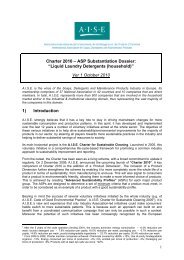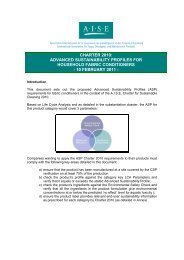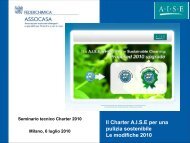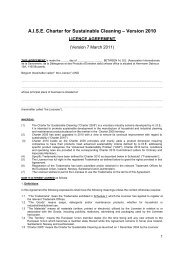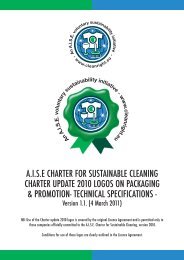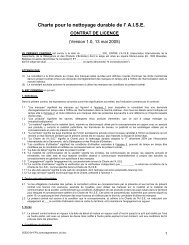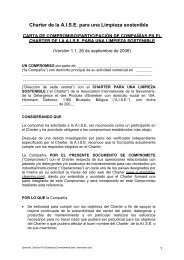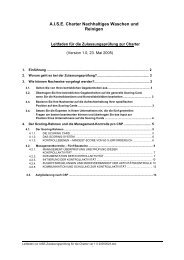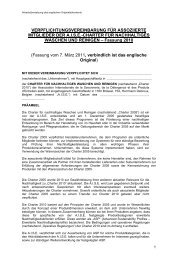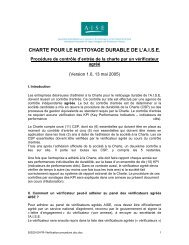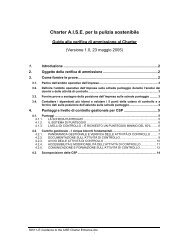English version - Sustainable Cleaning
English version - Sustainable Cleaning
English version - Sustainable Cleaning
Create successful ePaper yourself
Turn your PDF publications into a flip-book with our unique Google optimized e-Paper software.
INTRODUCTION<br />
A.I.S.E. CHARTER FOR SUSTAINABLE CLEANING<br />
KPI Reporting Detailed Explanation<br />
Version 2.3 (20 December 2012) “CHARTER UPDATE 2010”<br />
This document compiles the 11 key performance indicators and their specific measuring units and<br />
provides the participating companies a detailed reporting guidance.<br />
Companies admitted to the Charter will be asked to fill in – via a protected Charter Extranet – their<br />
annual data on all indicators before an indicated deadline. The individual company data will be kept<br />
confidential and will be automatically aggregated into the total industry data for the whole Charter<br />
area (= EU + Iceland, Liechtenstein, Norway and Switzerland).<br />
The indicators are valid for all A.I.S.E. sectors (household and I&I) but some of the measuring units<br />
are specific to either the household or the I&I sector.<br />
Aggregated results and benchmarking possibilities<br />
From one year to the next year it is possible to measure the overall industry trend towards continual<br />
improvement. Individual companies are able to benchmark their data with the average aggregated<br />
industry data.<br />
GENERAL REPORTING PRINCIPLES<br />
Companies are asked to report a total annual company figure per indicator:<br />
Multinational companies should report via their European Headquarters or any other designated<br />
reporting centre.<br />
Although the reporting country / countries should be indicated, national sustainability results<br />
cannot be provided as companies are supposed to report a single (Charter Area) figure per<br />
indicator.<br />
Companies report their indicators for a 12 month period ending during the Charter reporting<br />
year (the calendar year). Normally the 12 month period will be the same as the company’s<br />
financial year. The KPI reporting window is normally 1 Jan to 15 April immediately following the<br />
end of the Charter reporting year.<br />
The impact of mergers or other changes affecting the size of the company should only be taken<br />
into account as from the next, full reporting year.
Production coverage:<br />
The KPIs distinguish between a company’s total production and the production accounted for by the<br />
company’s sites as covered by the CSP verification (minimum 75% of total production). Most<br />
indicators relate to the latter, but not all. Where 100% of production is covered by the CSPs (as is<br />
the case for great majority of Charter Ordinary Members) there will be no difference. However<br />
companies are requested to be careful to provide the correct basis for their KPI report.<br />
No import / export data required:<br />
Time-consuming calculations for import and export are not necessary as it is reasonable to<br />
assume that the amount of imported products from outside the EU is comparable to the<br />
exported one.<br />
Some key economic data required for general information purposes:<br />
Participating companies are asked to indicate in the introduction part of their annual report their<br />
total annual turnover in the A.I.S.E. product areas as well as the countries in which they are<br />
operating (NB: these data will not be considered as indicators but will give an indication of the<br />
geographical coverage of the Charter within our industry).<br />
Companies are also asked to indicate in which sectors they are active (household, I&I or both)<br />
and if they can be considered as a multinational or a national (large, medium or small)<br />
company.<br />
INDICATORS<br />
Indicator 1)<br />
PARTICIPATING COMPANIES (All Sectors)<br />
Introduction<br />
The most critical success factor for a voluntary industry initiative such as the Charter is the number<br />
of participating companies – large, medium and small, active in the household and / or in the I&I<br />
sector. Not only the number of manufacturing sites covered has to be measured but also the total<br />
production volumes covered. Baseline-production data are needed for measuring continual<br />
improvement on all other indicators.<br />
Measuring units<br />
All Companies should report:<br />
a) their total number of manufacturing sites in the Charter area;<br />
b) the number of manufacturing sites covered by the Charter report;<br />
c) their total production, in tonnes in the Charter area;<br />
d) the production covered by the KPI report, in tonnes (minimum 75% of c))<br />
Household companies should report:<br />
e) their total production (in tonnes)<br />
a. in the Charter Area<br />
b. covered by the KPI report<br />
f) the total number of consumer units sold (in million units)<br />
a. in the Charter Area<br />
b. covered by the KPI report<br />
I&I companies should report:<br />
g) their total production (in tonnes)<br />
a. in the Charter Area<br />
b. covered by the KPI report<br />
h) the total number of units sold (in thousand units)<br />
a. in the Charter Area<br />
b. covered by the KPI report<br />
Reporting Guidelines<br />
Charter update 2010 KPI Detailed Explanation ver 2 3 20121220.doc 2
The data to be reported here are necessary for the calculation of the other indicators. The<br />
Extranet reporting system automatically calculates the performance ratios on the other KPI’s by<br />
linking the production data to the data to be reported on the other KPI’s;<br />
Only the part of business ‘in the control of the company’ should be reported, not the<br />
manufacturing sites controlled by third parties; a 50/50 joint venture is not in the control of the<br />
company for this purpose unless both owners are members of the Charter, in which case double<br />
counting should be avoided;<br />
Only the part of the business in the Charter Area (EU + Iceland, Liechtenstein, Norway and<br />
Switzerland) should be reported;<br />
If the Charter report covers all sites and the whole production is in the Charter area the same<br />
numbers have to be filled in under a-b) and c-d);<br />
For the purpose of the Charter KPI reporting the data only applies to A.I.S.E. product categories<br />
as in annex I;<br />
The production data should be reported with the water content as the finished product might<br />
also contain water.<br />
The reporting unit for household companies is ‘million consumer units’. A consumer unit is the<br />
unit of final consumption. The following items are considered as 1 consumer unit:<br />
a) A re-fill is one consumer unit even though it may fill more than one original package.<br />
b) A pack containing multiple individual doses not intended for individual re-sale<br />
The following items are NOT considered as 1 consumer unit:<br />
a) A twin-pack promotion would count as two consumer units.<br />
b) A multi-pack is counted as however many units are in the pack.<br />
I&I companies should only report the total number of units sold for products used in the<br />
subsectors Building care, Kitchen & catering hygiene and Professional laundry!<br />
Indicator 2)<br />
CHEMICALS SAFETY EVALUATION (Household and I&I Sector)<br />
Introduction (household sector only)<br />
Chemical substances are the main ingredients of detergents and cleaning products. The safety of<br />
these chemicals is crucial for consumer / customer confidence and the overall, societal reputation of<br />
the industry. Through participation in initiatives such as HERA, chemical substances in use by the<br />
industry are risk assessed and the detergent / cleaning products volume covered by risk<br />
assessment can be measured as well.<br />
Safety of I&I products is currently ensured by risk management measures taken on the basis of<br />
comprehensive set of specific regulations addressing occupational exposure and workers<br />
protection, as well as ingredients safety data sheets; the I&I sector of A.I.S.E. is reviewing HERA<br />
risk assessments for potential extension to I&I exposure conditions.<br />
Measuring units<br />
Companies should report<br />
a) the total amount of chemical raw materials used, in tonnes;<br />
b) the total amount of chemical raw materials covered by HERA risk assessments, in<br />
tonnes.<br />
Reporting guidelines<br />
Companies are not asked to sum up individual chemicals covered. The updated list of<br />
chemicals (CAS numbers) covered by the HERA Risk Assessments can be found on the HERA<br />
website: www.heraproject.com (click on ‘’risk assessments’’); In the future, the risk assessment<br />
will have to be consistent with the REACH Regulation and the REACH-related manuals.<br />
Water is here not considered as a raw material. As a consequence only the 100% active basis<br />
of the chemical ingredients – thus without the water content – should be reported.<br />
Introduction (I&I sector only)<br />
Charter update 2010 KPI Detailed Explanation ver 2 3 20121220.doc 3
The experience shows that manual product dosing frequently leads to reduced product use<br />
efficiency, either by overdosing (spoiling) or under-dosing (repeating the cleaning operation to get<br />
the job done). Therefore, producers promote and offer increasingly dosing devices to deliver<br />
appropriate product dosage. Furthermore, in terms of handling safety, manual dosing might cause<br />
more risk of direct exposure to products (skin, eyes, inhalation) than using dosing devices.<br />
This indicator aims at reflecting the evolution of use of dosing devices or systems by the customers<br />
to optimise (usually minimise) the products use and further increase safety at work.<br />
Charter update 2010 KPI Detailed Explanation ver 2 3 20121220.doc 4
Measuring Unit<br />
Companies should report:<br />
The total amount of products in weight (tonnes) produced by the company and per year for<br />
use under controlled dosing.<br />
Reporting Guidelines<br />
Depending on the application, dosing control ranges from using devices as simple as dosing<br />
caps or elementary mechanical dosing pumps to programming of completely automated<br />
ingredients injection at the different phases of a cleaning process (e.g. big laundries). These<br />
products (in liquid or solid form) are used either as such or diluted in the dosing control system.<br />
The compiled quantities are those that are delivered to the customers, not their equivalent after<br />
possible dilution.<br />
Indicator 3)<br />
OCCUPATIONAL HEALTH AND SAFETY (All Sectors)<br />
Introduction<br />
Occupational injuries can have outcomes with varying degrees of severity. Injuries, which are<br />
considered as ‘serious enough to require time off work for treatment and/or to recover’ are called<br />
‘Lost Time Accidents’.<br />
Benchmarking studies amongst A.I.S.E members in the past have revealed that this measure is<br />
already widely used. Indeed, lost time accidents, which require more than three days off work, are<br />
formally reportable to national health & safety regulators in many EU States.<br />
Measuring unit<br />
Companies should report<br />
a) The total number of accidents<br />
b) Total employees’ hours worked (in 1,000 man-hours)<br />
Reporting guidelines<br />
Companies should report the number of employee lost time accidents recorded during the year,<br />
where the time off work is equal to or greater than one days absence (excluding the day on<br />
which the accident occurred),<br />
Total employees’ hours worked is expressed per 1,000 man-hours worked by all employees in<br />
the sites covered by the Charter report;<br />
The result is the accident frequency rate:<br />
Accident Frequency Rate = Number of lost time accidents x 100<br />
Total Employees’ Hours Worked<br />
Indicator 4)<br />
CONSUMER AND CUSTOMER SAFETY (Household and I&I sector)<br />
Introduction<br />
Companies have made over the years significant progress in offering consumers / customers easier<br />
access to their Client Services. Phone lines (toll-free) and more recently e-mails are typical<br />
channels used for this purpose.<br />
Consumers have responded positively and incoming calls are increasing as a proof of the interest of<br />
consumers for more information. The possibility to have direct access to manufacturers is a signal<br />
for consumers of the openness of companies and of their willingness to respond to consumers’<br />
inquiries. Calls span over a very wide range of topics, from products to promotions, from complaints<br />
to testimonials, from search for advice to job applications.<br />
This channel also provides the opportunity to cover safety related topics and this allows<br />
manufacturers to monitor the real and perceived safety profile of their products in the market, the<br />
subject of this indicator.<br />
Charter update 2010 KPI Detailed Explanation ver 2 3 20121220.doc 5
Industrial & Institutional products deliveries are already accompanied by information and usage &<br />
safety instructions, at the minimum through a Product Safety Data Sheet and labelling on pack. This<br />
information is given for all new products delivery and often even for all deliveries. Therefore there is<br />
no real margin for a significant increase or improvement to be achieved.<br />
As a service to their customers, I&I suppliers also provide training for safe use of products and for<br />
systems / machines set-up optimisation. The complexity of these trainings depends on the type of<br />
application and their frequency varies from supplier to supplier and from customer to customer, the<br />
rotation of personnel being often important at customer level.<br />
This indicator will also show the commitment of the I&I sector to maintain and further improve the<br />
level of safety awareness of users at customers level.<br />
Measuring units (Household sector only)<br />
Companies should report:<br />
a) Names of all countries where a telephone or online care line service is indicated on pack<br />
as available in the country;<br />
b) Names of all countries where products are on the market;<br />
c) Total number of consumer contacts;<br />
d) The percentage of safety-related contacts within the total number of consumer contacts,<br />
classifying these contacts into two groups:<br />
a. Calls reporting real or perceived health problems, reported as being linked to the use<br />
of the product (e.g. exposure to skin or eyes or oral exposure);<br />
b. Inquiries (e.g. general or more specific questions related to the safety of the product,<br />
such as the presence of a certain ingredient, to which the consumer is allergic).<br />
Reporting Guidelines<br />
Companies commit to gradually set up care lines via a free phone number and/or e-mail. A care<br />
line service includes any of the following:<br />
o a company phone number;<br />
o a free-phone service;<br />
o an e-mail address;<br />
o an address for letters;<br />
o an online response service.<br />
Companies commit to record the total number of consumer contacts<br />
Companies commit to record the total number of “safety-related” consumer contacts according<br />
to the following classification:<br />
o Calls related to real or perceived health problems, reported as being linked to the use of the<br />
product (e.g. exposure to skin or eyes or oral exposure);<br />
o Inquiries (e.g. general or more specific questions related to the safety of the product, such<br />
as the presence of a certain ingredient, to which the consumer is allergic).<br />
Measuring unit (Industrial & Institutional Sector only)<br />
Companies should report<br />
e) The recorded number of equivalent customer-persons trained in sessions by companies<br />
(partly or totally) devoted to safe handling and use of products and systems (equipment),<br />
whatever the application (the evolution of this number will be explained taking into<br />
consideration market evolution and societal factors).<br />
Indicator 5)<br />
CONSUMER AND USER INFORMATION (Household and I&I sector)<br />
I. Safe use and best use information for consumer products (household only)<br />
Introduction<br />
The provision of appropriate information on how to use products can have positive impacts on the<br />
performance of a product, and hence the end results, whilst minimising the environmental impact<br />
and ensuring safety for consumers.<br />
Charter update 2010 KPI Detailed Explanation ver 2 3 20121220.doc 6
The advent of the Charter provides the opportunity to introduce small, but important improvements<br />
to the information provided to consumers via on-pack labelling and other communication tools have<br />
significant benefits in the everyday usage of Charter products by consumers.<br />
Companies which are members of the Charter are encouraged to use the maximum number of<br />
relevant messages for each product category. Companies which additionally claim ASP status for<br />
specific products must use Safe Use phrases and pictograms for these products s appropriate. The<br />
following set of rules applies:<br />
<br />
<br />
<br />
1 and 2: the pictograms should be applicable to all product categories, and the associated<br />
phrases used in addition as directed in the rules.<br />
3 and 4: the pictograms should be used on products that are likely to come into prolonged<br />
contact with skin, for example hand dish wash and hand wash laundry products, at<br />
companies’ discretion based on knowledge of their own specific products. The associated<br />
phrases should be used in addition as directed in the rules.<br />
5 to 8: the pictograms should be used as appropriate at the discretion of the company. For<br />
items 6.a and 6.b, the most appropriate message should be used recognising that they are<br />
designed for a normal or a refill pack respectively. The associated phrases should be used<br />
in addition as directed in the rules.<br />
This information should be grouped in a “Safe Use advice box” to draw consumers’ attention.<br />
A.I.S.E. expects companies to apply a stepwise approach: initially both pictograms and sentences<br />
will be shown with the objective to move to pictograms only when A.I.S.E. has evidence of<br />
consumer comprehension. The commitment to show these sensible advice phrases applies to all<br />
products either non-classified or classified by the Dangerous Preparations Directive. A.I.S.E. will<br />
provide appropriate guidance to avoid duplication and/or confusion for classified products.<br />
Charter update 2010 KPI Detailed Explanation ver 2 3 20121220.doc 7
Best use information<br />
Companies which are members of the Charter are encouraged to provide Best Use information<br />
wherever possible and practicable, either on pack or in related communications. Examples are<br />
contained in Annex II. Companies which additionally claim ASP status for specific products must<br />
use defined Best Use information on pack as provided for in the relevant category ASP rules. This<br />
on-pack Best Use information for ASP products will include as a minimum a reference to<br />
www.cleanright.eu<br />
Measuring Units<br />
Companies should report:<br />
a) Safe Use advice:<br />
Number of consumer product units sold in the Charter Area, using two icons/sentences<br />
(normally # 1 and 2), expressed as millions of units (m.u.);<br />
Number of consumer product units sold in the Charter Area carrying more than two<br />
icons/sentences, expressed as millions of units (m.u.).<br />
b) Best Use advice:<br />
<br />
Number of consumer product units sold in the Charter Area carrying relevant best use advice<br />
(existing A.I.S.E. best use advices for a number of product categories, professional graphic<br />
files and guidelines are available on www.aise.eu/end_user_info<br />
Reporting guidelines<br />
Reporting should deal with the safe use icons (accompanied by a safety phrase). Safety<br />
phrases alone should not be counted for this indicator.<br />
Only the original A.I.S.E. safety icons may be counted for this KPI, not company-specific icons<br />
II.<br />
Proper and safe use of I&I products (I&I sector only)<br />
In order to facilitate the communication with the users in the I&I sector, A.I.S.E. developed<br />
pictograms for two important activity sub-sectors: Building care and Kitchen & catering hygiene.<br />
This indicator aims at demonstrating the wide use of these pictograms.<br />
Measuring Units<br />
Companies should report:<br />
a) the total number of units sold (in thousand units) for products used in the two sub-sectors<br />
(see reporting guidelines)<br />
b) the number of units sold (in thousand units) showing one or more A.I.S.E. pictograms.<br />
Reporting guidelines<br />
Reporting deals with the number of units sold for Building care and Kitchen & catering hygiene<br />
only<br />
Charter update 2010 KPI Detailed Explanation ver 2 3 20121220.doc 8
Indicator 6)<br />
POORLY BIODEGRADABLE ORGANICS (PBO’s) USED (All Sectors)<br />
Introduction<br />
Poorly biodegradable organic compounds (PBO’s) have been in the public’s attention over the past<br />
decades as a potential long-term environmental issue. The Charter PBO Indicator is intended to call<br />
companies’ attention to reducing these substances whenever the reduction would bring<br />
environmental benefit and would be technically feasible.<br />
Measuring Unit<br />
Companies should report:<br />
a) the purchased quantities of chemicals (according to the Charter PBO-list) in weight<br />
(tonnes)<br />
Reporting guidelines<br />
Definition of the Poorly Biodegradable Organics:<br />
Substances/materials that are neither readily nor inherently biodegradable 1 have been included<br />
in the Charter PBO List (see annex III) and the Charter reporting should be based on this List. A<br />
few of the chemical groups listed may include biodegradable elements which can be exempted<br />
from PBO allocation provided it is justified by appropriate data. It is likely that the List will not<br />
contain all chemicals 2 used by companies participating to the Charter. If a known PBO not<br />
covered by the Charter PBO List is used by a company this substance/material should also be<br />
reported against the PBO key performance indicator.<br />
All products produced and sold to the consumer and/or I&I cleaning applications should be<br />
considered when the PBO’s are reported.<br />
Please report on the active substance without water included.<br />
1<br />
Organic substances are considered PBO if their biodegradability is below 70% in an inherent<br />
biodegradability test system (SCAS or Zahn-Wellens test). This threshold is a priori exceeded by readily<br />
biodegradable substances.<br />
2 Substances not appearing on the PBO list, but for which there are test data or a structural indication that<br />
they are likely not to be inherently biodegradable should be considered as PBOs.<br />
Charter update 2010 KPI Detailed Explanation ver 2 3 20121220.doc 9
Indicators 7, 8 and 9: CONSUMED ENERGY AND CO-2 EMITTED, CONSUMED WATER,<br />
WASTE (TOTAL AND HAZARDOUS) (All Sectors)<br />
Introduction<br />
Environmental emissions to air, water and land are measured in variety of ways within industry. Of all<br />
these measures it is recognised that waste (both hazardous and non hazardous) which is sent off-site<br />
for disposal by landfill, incineration etc., and which is not recycled, has a significant environmental<br />
aspect for most of the companies within the A.I.S.E. It is further recognised that the consumption of<br />
energy e.g. gas, oil, electricity and water by the companies that comprise the A.I.S.E also has a<br />
significant environmental impact.<br />
Benchmarking studies amongst A.I.S.E members in the past have revealed that these measures are<br />
already widely used and are often included in external reports on company environmental<br />
performance and sustainability.<br />
The Measuring Units for the Indicators defined in the Environmental Pillar are:<br />
Indicator 7) CONSUMED ENERGY AND CO-2 EMITTED<br />
Companies should report<br />
a) the amount of energy consumed per annum expressed in GJ of energy .<br />
Reporting guidelines<br />
Include all fuels used on the site e.g. gas, oil, electricity etc.;<br />
Do not include electricity that is generated on site – enter instead the energy value of the fuel that<br />
is used for its generation.<br />
Where steam or electricity is produced on site, but some of it is sold to an adjacent site or third<br />
party facility or operation, subtract the amount sold from the total energy reported;<br />
The energy content (also known as calorific value) of each fuel should be known locally but<br />
default values are provided below.<br />
Typical Energy Contents of Fuels<br />
Fuel Units Energy Content (GJ per tonne or m 3 )<br />
Coal Tonnes 29.30<br />
Heavy fuel oil Tonnes 41.35<br />
Light fuel oil Tonnes 43.00<br />
Gas M 3 0.0366<br />
Liquid Petroleum Gas Tonnes 46.00<br />
Steam / Hot Water purchased externally Tonnes 2.75<br />
Wood Tonnes 15.30<br />
Note: Energy contents of fuels from (ESU-ETHZ, 1994; supplemented by APME, 1993; Baehr, 1989; SAEFL-<br />
132, 1991)<br />
b) The amount of CO 2 emitted per annum expressed in tonnes of CO 2 .<br />
Reporting guidelines<br />
This calculation should be done with reference to the amount of energy consumed and the<br />
composition of the energy mix.<br />
In particular for smaller companies: contact your fuel/energy provider(s) for details of the<br />
composition of the fuel/energy consumed i.e. kilograms of CO 2 per GJ.<br />
The con<strong>version</strong> calculation method can also be derived from the GHG Protocol Calculation<br />
Tools of the World Business Council for <strong>Sustainable</strong> Development (www.ghgprotocol.org)<br />
Charter update 2010 KPI Detailed Explanation ver 2 3 20121220.doc 10
Indicator 8)<br />
CONSUMED WATER<br />
Measuring unit<br />
Companies should report:<br />
a) the amount of water (potable and non potable) consumed per annum expressed in m 3 of<br />
water.<br />
Reporting guidelines:<br />
This information is generally available on the quarterly invoice from the water supplier or in the<br />
case of on site water sources e.g. wells, can be measured using a meter.<br />
Water added directly in the products is to be included in this indicator.<br />
Indicator 9)<br />
WASTE – Off Site, For Disposal (Total Waste - Hazardous plus Non Hazardous)<br />
Measuring unit<br />
Companies should report<br />
a) the total amount of waste (hazardous and non hazardous) sent off site per annum<br />
expressed in tonnes;<br />
b) of which the amount of hazardous waste sent off-site per annum in tonnes.<br />
Reporting guidelines:<br />
Waste that is reused or recycled on site should not be included as it has not left the site;<br />
Waste that is stored on site should not be reported until it leaves the site;<br />
The classification of waste as either hazardous or non-hazardous should be based on the local<br />
legislation for the reported country / countries.<br />
Indicator 10) PACKAGING USED (All Sectors – Industrial and Institutional Sector)<br />
Introduction<br />
The consumption of packaging, in particular for consumer goods is regarded by society as an<br />
important environmental performance indicator for the industry. Therefore the A.I.S.E. will report the<br />
packaging ratio, expressed as the total amount of packaging (tonnes) related to total amount of<br />
products (tonnes) put on the market.<br />
The A.I.S.E. Industrial & Institutional sector delivers a significant amount of their products in<br />
refillable “big” containers (drums, IBCs, tank truck loads). Consequently, the amount of products<br />
delivered in refillable bulk containers per year will be reported exclusively by the A.I.S.E. Industrial &<br />
Institutional sector.<br />
Measuring unit (All Sectors)<br />
Companies should report<br />
a) the total amount of packaging material in weight (tonnes) purchased 5 per year<br />
Reporting Guidelines<br />
Companies are requested to report the total packaging material purchased at Charter Area<br />
level; this should be one number; i.e. not split by material (plastic, paper, etc.) or by industry<br />
sector (Household, I&I).<br />
Only packaging that is actually filled by the companies themselves should be considered;<br />
The submission will include tonnage coming from primary, secondary and tertiary packaging up<br />
to a nominal quantity of 25 kg/l of the primary pack but no pallets and no refillable bulk<br />
containers;<br />
Included are regular packs and promotional packs, e.g. boxes, bags, bottle, aerosol cans etc.;<br />
Special items such as trigger sprays and measuring devices are only included if they are an<br />
integral part of the pack (for example a closure that functions as a dosing device).<br />
Refillable containers will be included only if sold filled (i.e. newly purchased);<br />
No data will be generated on display material in general and on separate dosing devices.<br />
5 The choice of data sources is left at the discretion of the reporting companies providing the reported data cover the<br />
packaging materials quantity as defined in the guidelines.<br />
Charter update 2010 KPI Detailed Explanation ver 2 3 20121220.doc 11
Analysis of the reported data<br />
The evolution of the aggregated (Charter Area) data might need to be explained. In case of<br />
substantial external influences beyond our control, the explanation will include references to<br />
explanation factors 3 reflecting the respective external elements influencing the market. The<br />
explanation will highlight the efforts our industry makes to optimise packaging material use and - to<br />
the degree possible - to counterbalance the potential growth caused by external factors.<br />
Measuring Unit (Industrial & Institutional Sector only)<br />
Companies should report<br />
b) the use of refillable containers: total amount in weight (tonnes) of products delivered in<br />
refillable containers per year.<br />
Reporting Guidelines<br />
The reported amounts should be grouped at Charter Area level and should include all products<br />
delivered in refillable containers of more than 25 kg or litre. This includes also tank-truck loads.<br />
Indicator 11) PRODUCTS WITH ASP STATUS<br />
The main new feature in the Charter 2010 package which differentiates it from Charter 2005 is the<br />
creation of the “Product Dimension”. It is a voluntary extension available to Charter members, and<br />
does not affect existing Charter rights. The Product Dimension extends the Charter’s scope so that<br />
a differentiated logo on pack may be used which signifies not only that the manufacturer is<br />
committed to certain sustainability processes at the manufacturing level (as under Charter 2005),<br />
but also that the product itself meets certain advanced sustainability criteria created for each<br />
A.I.S.E. product category, whether in the household or in the industrial & institutional cleaning<br />
sector; those are called the Advanced Sustainability Profiles (ASP). To distinguish products which<br />
meet the category ASP a special <strong>version</strong> of the Charter Logo is introduced.<br />
This KPI aims at tracking progress of the Advanced Sustainability Profiles (ASP). It deals with the<br />
number of products placed on the market by each Charter Member which have ASP status. The<br />
KPI is reported for Household products and I&I products separately in the following units:<br />
Measuring Unit (Household Sector only)<br />
<br />
Number of Household products placed on the market which carry the ASP logo (see KPI 1 for<br />
the definition of consumer unit)<br />
Measuring Unit (Industrial & Institutional Sector only)<br />
<br />
Number of I&I products placed on the market which have ASP status, expressed in units sold (in<br />
thousand units) in the subsectors Building care, Kitchen & catering hygiene and Professional<br />
laundry<br />
- o – o – O – o – o -<br />
3 An appropriate A.I.S.E. Task Force will monitor the Explanation Factors. They could be for example the evolution of<br />
demographic indicators (influencing the total market), the trend towards smaller and more numerous households (leading<br />
to smaller pack sizes), the general trend to more convenience in life (more convenient package executions and product<br />
forms, dispensing features or pre-dosed products), the progress in recovery systems achievements, currencies<br />
fluctuations, and feedstock materials’ market evolution. These would be applied retrospectively on a yearly basis as<br />
appropriate.<br />
Charter update 2010 KPI Detailed Explanation ver 2 3 20121220.doc 12
ANNEX I<br />
A.I.S.E. Category Products<br />
<br />
<br />
<br />
<br />
<br />
<br />
<br />
Soaps<br />
o<br />
Hard soaps (soaps, excluded from the Cosmetics Directive (i.e. not intended for the<br />
body))<br />
Household Laundry Products<br />
o Fabric washing (powders, tablets and liquids), fabric softeners, auxiliary products<br />
Household Dishwash Products<br />
o Hand wash, machine wash, auxiliary products<br />
Hard Surface Household Cleaners<br />
o All purpose cleaners, scouring cleaners, window cleaners, toilet bowl cleaners, speciality<br />
products<br />
Domestic Bleach Products<br />
o Hypochlorite-based products, other bleach products<br />
Domestic Maintenance Products<br />
o Wood, leather, household metals, maintenance, insecticides, disinfectants, room<br />
deodorisers, specialist application products, other specialities<br />
Industrial & Institutional Products<br />
o Industrial hygiene (e.g. food & beverage industry)<br />
o Professional laundry<br />
o Kitchen & Catering<br />
o General Surfaces (hospital hygiene, offices, public places, etc.)<br />
o Others (industrial metal cleaning, car & truck wash, process water treatment)<br />
Charter update 2010 KPI Detailed Explanation ver 2 3 20121220.doc 13
ANNEX II<br />
End User Information<br />
A.I.S.E. best use advices for a number of product categories, professional graphic files and<br />
guidelines are available on www.aise.eu/end_user_info<br />
Charter update 2010 KPI Detailed Explanation ver 2 3 20121220.doc 14
ANNEX III<br />
Poorly Biodegradable Organics (PBO) in products subject to the A.I.S.E. Charter<br />
Below is a list of major chemical groups or chemicals representing product ingredients that are considered to<br />
fulfil the criteria for PBO, i.e. being neither readily nor inherently biodegradable*. A few of these chemical<br />
groups may also include biodegradable elements which can be exempted from PBO assignment provided it is<br />
justified by concrete data. It is inevitable this list will not contain all chemicals used by A.I.S.E. member<br />
companies or associations. If a known PBO not covered by the list below is in use this should also be<br />
reported against the PBO key performance indicator within the A.I.S.E. Charter for <strong>Sustainable</strong> Development.<br />
*Organic substances are considered PBO if their biodegradability is below 70% in an inherent biodegradability<br />
test system (SCAS or Zahn-Wellens test). This threshold is a priori exceeded by readily biodegradable<br />
substances.<br />
Substances not appearing on the PBO list, but for which there is a structural indication that they are likely not<br />
inherently biodegradable, or for which data are available showing lack of inherent biodegradability, should be<br />
considered as PBOs.<br />
PBO Chemicals/Chemical Classes<br />
Polymers:<br />
Polycarboxylates<br />
Carboxmethyl cellulose and other cellulose<br />
derivatives<br />
Polystyrene latex<br />
Polysiloxane polymers (silicones)<br />
High Molecular Weight Polyethylene Glycols (MW ><br />
4 000)<br />
Polyvinyl pyrrolidone (PVP) and related polymers<br />
Nonionic terephthalate polymers (soil release<br />
polymers)<br />
EO/PO block polymers (Except representatives<br />
shown to be outside PBO definition, e.g. EO-PO<br />
based surfactant should not be specified here as<br />
they are readily biodegradable)<br />
Other homo- and co-polymers (Except<br />
representatives shown to be outside PBO definition,<br />
e.g. readily biodegradable substance)<br />
Paraffins<br />
Substance groups and individual substances:<br />
Fluorescent whitening agents (Optical<br />
brighteners)<br />
Dyes and pigments<br />
Phosphonates (acid and salts)<br />
Perfumes<br />
Preservatives (Except representatives shown to be<br />
outside PBO definition, e.g. readily biodegradable<br />
substance)<br />
Examples include<br />
sodium polyacrylate<br />
acrylic acid homopolymer<br />
acrylic acid/laurylmethacrylate copolymer<br />
maleic acid/acrylic acid copolymer<br />
carboxymethylcellulose (CMC)<br />
hydroxymethyl cellulose<br />
sodium carboxymethylcellulose<br />
cellulose, carboxymethylether, sodium salt<br />
polymerised styrene monomer (= polystyrene)<br />
polystyrene latex<br />
polydimethylsiloxanes<br />
polydimethyl cyclosiloxanes<br />
silicone derivatives<br />
2-pyrrolidinone, 1-ethenyl-, homopolymer<br />
polyvinylpyrrolidone (PVP)<br />
poly (N-vinyl-2-pyrrolidone)-poly (N-vinyl-imidazol)<br />
poly 4-vinylpyridine-N-oxide<br />
polyesters (soil release polymers)<br />
bis-(poly-ethoxylated) poly-(1,2 polypropylene terephthalate)<br />
diethoxylated poly (1,2 propylene terephthalate)<br />
paraffin waxes<br />
paraffin derivatives<br />
dimorpholino type optical brighteners<br />
disulphostyryl biphenyl type optical brighteners<br />
disodium 4,4’-bis ((4-anilino-6-morpholino-1,3,5-triazin-2-<br />
yl)amino)stilbene-2,2’-disulphonate<br />
disodium 2,2’-((1,1’-biphenyl)-4,4’-<br />
diyldivinylene)bis(benzenesulphonate)<br />
al-phthalocyanine compound<br />
zinc phtalocyanine sulphonate<br />
amino-tris(methylene phosphonic acid)<br />
tetrasodium (1-hydroxyethylene bisphosphonate)<br />
diethylenetriamine penta (methylenephosphonic acid)<br />
Imidazolinium derivatives (Except readily biodegradable<br />
derivatives)<br />
Charter update 2010 KPI Detailed Explanation ver 2 3 20121220.doc 15
PBO Chemicals/Chemical Classes<br />
Benzotriazole and derivatives<br />
EDTA (acid and salts)<br />
Butyl hydroxytoluene (BHT)<br />
Organic chlorine bleaches<br />
Fluorosurfactants<br />
Examples include<br />
Sodium dichloroisocyanurate, trichloroisocyanuric acid<br />
Perfluro-octanes (PFOS/PFOA), fluorotelemetric chemistry.<br />
Charter update 2010 KPI Detailed Explanation ver 2 3 20121220.doc 16



